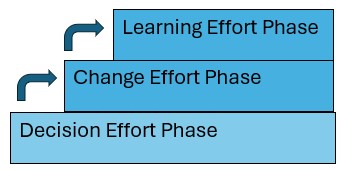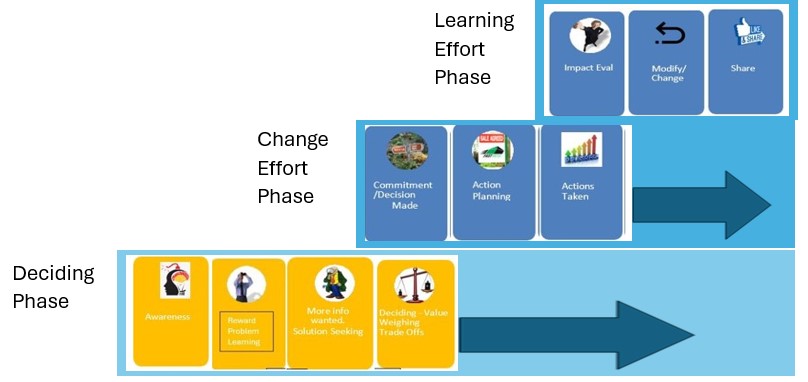As a student, you are constantly faced with new information, learning skills, and challenges to overcome. Your approach to learning can significantly impact your success, especially when it comes to being ready to learn. The best way to be prepared to learn is to make decisions about learning material such as books, podcasts, and videos that are interesting and relevant to you. These materials will complement the required materials from your course and make your learning more enjoyable. The Learning Motivator helps enhance your learning experience by guiding you in building motivation and selecting the best materials that combine the course’s learning outcomes and your unique interests. It optimizes your brain’s readiness to learn and keeps you motivated throughout the process, making it a valuable tool for learning.
How We Learn
Learning has two main phases. The first phase involves acquiring new knowledge, while the second phase focuses on improving skill and knowledge application through practice. The quality of knowledge and skill acquisition greatly influences the success of practice. This underscores the importance of practice in skill acquisition, motivating you to engage in active learning. Combining acquisition and practice allows the learner to achieve adequate performance and produce results through plan execution. Therefore, how can you optimally acquire learning to ensure that practice leads to high performance?
The brain learns by upgrading or modifying an existing way of doing something or learning something new to satisfy a need. When the need is clarified, it triggers the phases of decision-making and managing a change effort that supports learning. The brain learns best from a tangible experience that includes understanding the relationships of the parts to the whole and the relevance of the learning. This is why hands-on learning, which involves creating and building, is so effective. Using tools that target decision-making and learning enhances your ability to acquire new knowledge, apply it effectively, and retain it for the future.

Once the subject matter is deemed relevant to a person’s role and life needs, they are ready to commit to learning. This active learning process, which includes building and constructing, is not just important but crucial in enhancing learning efforts. The process may involve prototyping, where the lessons learned are applied to create an object or outcome. This hands-on experience can significantly improve the areas of the brain responsible for memory and motor learning. For example, reading or watching content about riding a bike is not as effective as practicing riding to acquire the skill.

Maximizing Motivation for Better Learning
Motivation is not just a factor; it’s the driving force behind how well you learn. Motivations are personal and different for each student; as a result, the student will need to determine their motivation for learning the subject. As Galileo famously wrote, “We cannot teach people anything; we can only help them discover it within themselves.” From this perspective, the student is responsible for all learning. The areas of the brain that release the cognitive resources needed for learning must be convinced that the energy used will be worth it. This changes the instructor-student relationship as well.
Unlike the traditional classroom, where the teacher teaches, and the learner learns, in a classroom that promotes learning through decision-making, the instructor’s role is to make learning materials available for the students to select at their level. The instructor does this by first evaluating the student’s knowledge and skill level and determining where they are in the curriculum. Materials that meet the student’s level are made available for the student to select from. This approach empowers students to activate their innate learning by selecting relevant and exciting material, fostering a sense of control over their learning journey. Selecting relevant and engaging material is a helpful way to maintain motivation.
However, learning complex information over a long time makes it easy to lose motivation. Sometimes, a student will start to study material and have to stop due to fatigue a few hours later. Only then do they realize that they have not learned and that the time spent was wasted. This can be discouraging, and the student is unlikely to return to the material until the time pressure of an upcoming exam forces them into memorization.
Studying and doing the worksheets is one thing, but are you really learning it or just remembering for a while? There is a significant difference between memorizing and recalling information and acquiring the skills and knowledge of the lessons. If you rely only on memorization, it will be a shaky foundation for future learning. What is needed is a way to optimize the acquisition of skills and knowledge such that it becomes the students’ knowledge, and they can use it in their daily lives to complete tasks and make progress.
The Learning Motivator Web-based Tool
This is why the Learning Motivator tool was developed for students. To help them develop and maintain motivation and learn through real-world practice as they progress through the curriculum. It includes components of the DDMP and applying them to learning. The first two steps of the DDMP focus on developing awareness of information’s relevance and triggering the brain’s motivation areas. When you are motivated, you’re not just more likely to engage with the material; you’re actively participating in your learning journey, staying focused, and putting in the effort needed to master new concepts. However, staying motivated can be challenging, especially when the subject matter is complex or under pressure.
The Learning Motivator helps you optimize your motivation by aligning your learning with your values and roles in your life. It activates the areas of the brain responsible for motivation, making it easier to see the material’s relevance to your future. Instead of seeing assignments or tasks as just things you need to get through, you’ll begin to view them as opportunities to improve and achieve your long-term objectives. This shift in perspective boosts your engagement and keeps you driven, even when faced with tough challenges. When your motivation is high, your brain is more receptive to learning, meaning you understand the material better and retain it longer. The sense of accomplishment you feel when you apply your learning in real-life situations further fuels your motivation and enhances your learning experience.
Learning by Doing: Prototyping and Skill Mastery
One of the most effective ways to learn is through doing. Rather than simply reading about a concept or watching a demonstration, actively applying what you’ve learned helps reinforce the material and build practical skills. This hands-on approach is known as prototyping, where you experiment, make structured mistakes, and refine your understanding based on real-world practice. It may look like practicing bike riding, as previously discussed, or creating an object of art or science.
The Learning Motivator improves the brain’s learning readiness to benefit from prototyping. The deliberate decision-making system, which helps you learn new skills, is activated as you engage in trial and error. This system guides you in making informed decisions about approaching problems, helping you understand the why and how behind your actions. To optimize the prototyping, the involved areas of the brain need to be activated. This is done through the first phase of the DDMP, which is focused on decision-making. The result of completing this phase, as demonstrated in the Learning Motivator, is a commitment to learning that supports the prototyping and the likelihood of many different iterations over a long period.
Acquiring new information is the first step. However, learning also requires repetition to consolidate the learning of new material. As you repetitively practice these skills and they become familiar, your Automatic decision-making system kicks in, helping you to perform tasks more efficiently and confidently. The Automatic system includes the areas of motor learning and memory. Over time, repetitive practice supported by Learning Motivator helps turn new skills into habits, meaning you can rely on them in the future without having to overthink. In this way, you have acquired the information, made it your own, and integrated it into making need fulfillment and role performance more predictable and sustainable.
Preparing Your Brain for Optimal Learning
As a student, you may have experienced times when learning felt especially difficult—whether due to time pressure, stress, or cognitive overload. These factors can negatively impact your brain’s ability to process and retain information. As a complement to the Learning Motivator, other tools based on the DDMP address these challenges by preparing your brain to learn under various conditions. DDMP tools can help you manage these external pressures more effectively. The web-based tools can help regulate your brain’s response to stress, freeing up cognitive resources so that you can focus on learning instead of feeling overwhelmed. Additionally, DDMP encourages strategic decision-making, helping you prioritize tasks and manage your time more effectively.
This preparation not only improves your ability to absorb new information but also ensures that you can apply what you’ve learned when it matters most—whether in exams, presentations, or real-world situations.
Unlock Your Full Learning Potential
Whether you’re learning a new programming language, mastering a complex math formula, or developing a research project, the Learning Motivator helps you learn more efficiently by engaging both decision-making systems—deliberate for learning and automatic for mastering. It offers a way to transform how you approach learning by helping you build motivation, master skills through prototyping, and optimize your brain for better knowledge retention. As a student, these tools are invaluable for helping you navigate the demands of your education while staying focused on your personal and academic goals.
With DDMP, you can enhance your learning experience, making it more efficient, engaging, and effective. It’s time to take control of your learning journey, tap into your brain’s full potential, and set yourself up for success—both in your studies and beyond.
You can try the Learning Motivator at the following site:
